We use cookies to make your experience better. To comply with the new e-Privacy directive, we need to ask for your consent to set the cookies. Learn more.
The growing regions in China
Classification of production regions
The tea plant is cultivated in large parts of China. There are tea plantations in 20 of the 32 provinces.
The climate conditions in the growing regions range from tropical, subtropical to temperate.
The highest growing region is about 2600 metres above sea level and the lowest less than 100 metres above sea level.
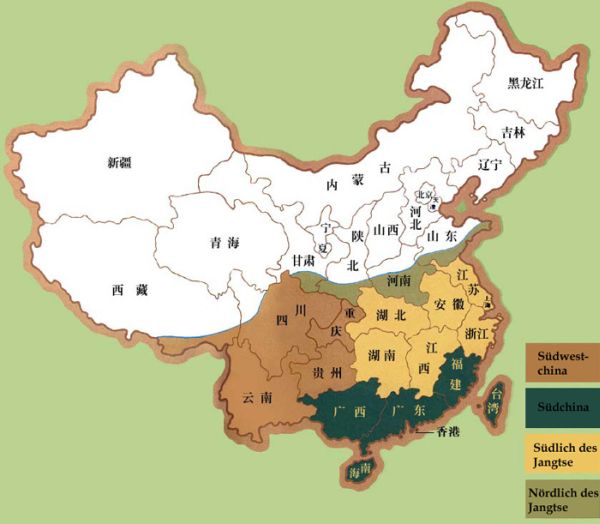 The Chinese growing regions are divided into 4 categories: the south-western growing regions, the southern Chinese growing regions, the growing regions south and north of the Yangtze River.
The Chinese growing regions are divided into 4 categories: the south-western growing regions, the southern Chinese growing regions, the growing regions south and north of the Yangtze River.
Although China has the world's largest total area under tea cultivation, the yield per area is much lower than in other tea producing countries such as India, Sri Lanka or Japan.
This is probably mainly due to the fact that the areas under cultivation are very widely scattered across the country.
There are only a few concentrated areas in the provinces of Fujian and Zhejiang.
Both provinces account for almost half of China's annual production, with green tea being grown mainly in Zhejiang and black tea and oolong being grown mainly in Fujian.
The Chinese growing regions are divided into 4 categories:
- the south-western growing regions: They comprise the provinces of Sichuang, Yunnan, etc. Particularly well known from these regions is black tea like the Pu Er tea.
- the southern Chinese growing regions: They include the provinces Guangdong, Fujian, Taiwan, etc Important cultivation regions for the Chinese black tea. Famous are the Oolongs from Fujian and Taiwan.
- the growing regions south of the Yangtze River: they include the provinces of Zhejiang, Jiangxi, Hunan, Hubei, Jiangsu and Anhui. These are the most important growing regions in China, as mainly green teas are produced. Most of the well-known green teas like the Lung Ching and the Pi Lo Chun come from these regions.
- and the growing regions north of the Yangtze river: because of the comparatively unfavourable growing conditions there are only very few known Teas.
Interestingly, many growing regions have a lot to offer in terms of landscape as well as tea.
The following 4 growing regions are certainly also among the most visited tourist destinations in China.
A trip there would certainly not only be interesting because of the tea.
The most beautiful growing regions
Hangzhou city and surroundings
The provincial capital of
 Zhejiang
Zhejiang
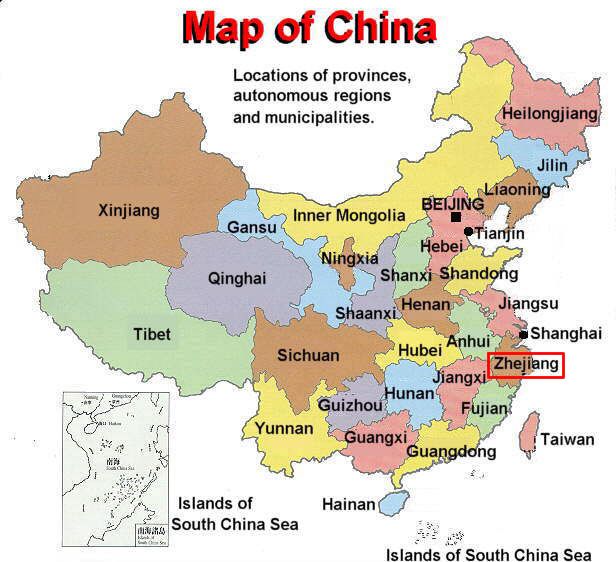 , 200 kilometres southwest of Shanghai, is one of the most beautiful cities in China,
known for its beautiful landscape and the finest green tea in China - the Lung Ching. Hangzhou is one of the 10 most visited destinations in China.
The city centre is located directly on the eastern shore of the West Lake (see picture),
because only from this side the lake is not surrounded by mountains and hills.
, 200 kilometres southwest of Shanghai, is one of the most beautiful cities in China,
known for its beautiful landscape and the finest green tea in China - the Lung Ching. Hangzhou is one of the 10 most visited destinations in China.
The city centre is located directly on the eastern shore of the West Lake (see picture),
because only from this side the lake is not surrounded by mountains and hills.
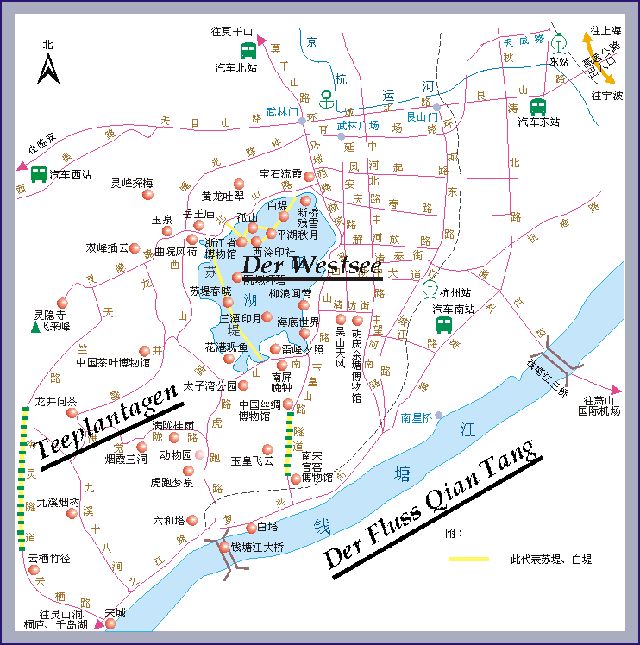
A rough city map of Hangzhou South of the city runs the Qian Tang River, which flows into the East China Sea shortly after Hangzhou.
The first reliable written record of the town is found in the historical records (Shi Ji) from Sima Qian (145 - 87 b.o.c.). Afterwards the first emperor of China (Qin Shi Huang Di), who had just on his 5th and last round trip through the country, in the year 210 B.C.E. by here from the Qian Tang River and was prevented from doing so by a storm. The town remained a small, insignificant district town for a long time afterwards. The ascent Hangzhous has 3 events to thank for in the period between the 6th and 12th centuries:
Early 7th century
At the beginning of the 7th century, Hangzhou was directly connected to the capital (Chang'an, northwest China) by the Great Canal (the Imperial Canal) via waterway.
Late 9th century - mid 10th century
With the decline of the Tang Dynasty, the empire disintegrated into many kingdoms. Fierce military conflicts were the order of the day. The only kingdom, which had been spared to some extent from major destructive wars, was the Kingdom of Wu-Yue, whose capital was Hangzhou. This had particularly affected the more prudent kings of the empire, who were more concerned with prosperity than with territorial respected the claims of the Reich. Thus Hangzhou was the only well-preserved metropolis until the foundation of the Song Dynasty in 960.
From 1127
Economically, the Song Dynasty was one of the most prosperous dynasties in Chinese history. Militarily, however, it was a catastrophe: It barely won a war against the equestrian peoples such as the Khitan or the Tungus, who were advancing south from Manchuria. The Song Empire had to pay high annual tributes to these peoples, the most sought-after being tea and silk.
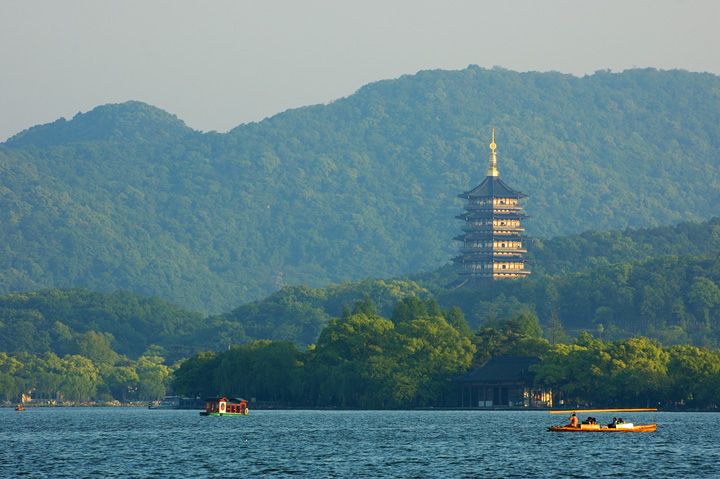
The West Lake In 1127 the greatest humiliation occurred: The song capital was destroyed after a military conflict was taken by the Khitan, the ruling emperor and his abdicated father, who was himself an avid tea drinker, were captured and put into an underground cave. North China was thus a very important region for the Song Dynasty completely lost. The imperial court in Hangzhou set itself up provisionally and set a new emperor, who of course had no interest in seeing his father and to free his brother from captivity, otherwise his legitimacy as Emperor had ended. Thus Hangzhou remained until the destruction of the Song Dynasty by the Mongols the capital. A remnant from this time can still be seen today: Most of the inhabitants of Hangzhou speak a mixed dialect of southern and Northern Chinese.
The city of Hangzhou has grown rapidly in recent years and is now home to almost 4 million people in the city area. Despite the strong modernisation, the city fathers, unlike in many other Chinese cities, have shown foresight and have not allowed the construction of modern buildings around the lake. Thus the view from the eastern shore
the view from the eastern shore
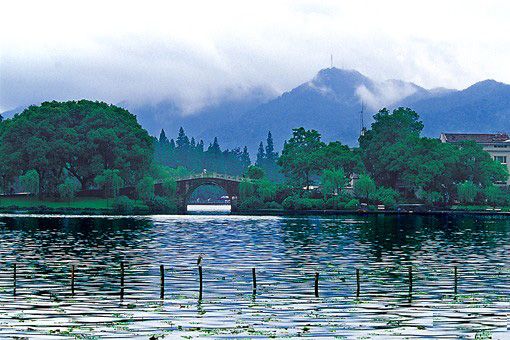 towards the lake and its surroundings has remained as beautiful as ever.
towards the lake and its surroundings has remained as beautiful as ever.
If you want to stay away from the tourist hustle and bustle around the lake - at peak times several million tourists can be at the lake in a single day - you can take a
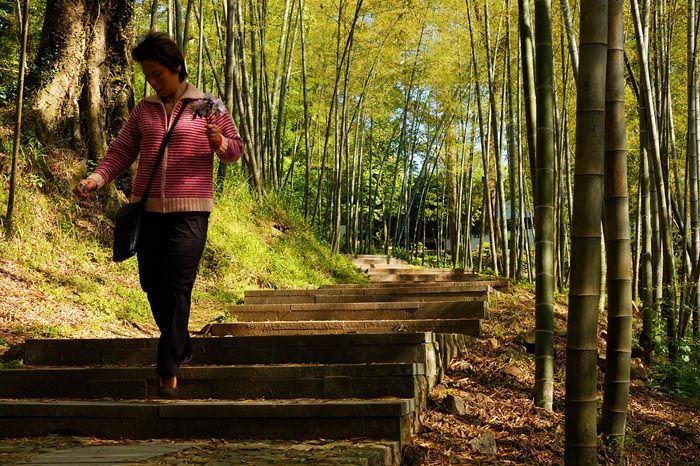 Hiking trail through a bamboo forest. In the background a monastery on the top of one of the many hills, a great place to drink tea.
walk through the tea plantations.
The plantations for the famous Lung Ching tea are located on the hills
Hiking trail through a bamboo forest. In the background a monastery on the top of one of the many hills, a great place to drink tea.
walk through the tea plantations.
The plantations for the famous Lung Ching tea are located on the hills
 southwest of the lake and north of the river.
southwest of the lake and north of the river.
 Between the plantations there are many beautiful hiking trails. If you get thirsty on the way, there are many ways to enjoy a cup of tea.
Whether in a monastery or at the farmers home or at one of the many street tea taverns, Lung Ching tea simply tastes best in Hangzhou.
Between the plantations there are many beautiful hiking trails. If you get thirsty on the way, there are many ways to enjoy a cup of tea.
Whether in a monastery or at the farmers home or at one of the many street tea taverns, Lung Ching tea simply tastes best in Hangzhou.
For some years now, the tea plant has been further refined for Lung Ching tea and the cultivation has been extended to the surrounding towns. In terms of taste, these teas differ only slightly from the Lung Ching directly from Hangzhou, but cost far less. But for an original Lung Ching tea from Hangzhou, a Chinese tea lover is still willing to pay 10 times more.
 Zhejiang
Zhejiang


A rough city map of Hangzhou South of the city runs the Qian Tang River, which flows into the East China Sea shortly after Hangzhou.
The first reliable written record of the town is found in the historical records (Shi Ji) from Sima Qian (145 - 87 b.o.c.). Afterwards the first emperor of China (Qin Shi Huang Di), who had just on his 5th and last round trip through the country, in the year 210 B.C.E. by here from the Qian Tang River and was prevented from doing so by a storm. The town remained a small, insignificant district town for a long time afterwards. The ascent Hangzhous has 3 events to thank for in the period between the 6th and 12th centuries:
Early 7th century
At the beginning of the 7th century, Hangzhou was directly connected to the capital (Chang'an, northwest China) by the Great Canal (the Imperial Canal) via waterway.
Late 9th century - mid 10th century
With the decline of the Tang Dynasty, the empire disintegrated into many kingdoms. Fierce military conflicts were the order of the day. The only kingdom, which had been spared to some extent from major destructive wars, was the Kingdom of Wu-Yue, whose capital was Hangzhou. This had particularly affected the more prudent kings of the empire, who were more concerned with prosperity than with territorial respected the claims of the Reich. Thus Hangzhou was the only well-preserved metropolis until the foundation of the Song Dynasty in 960.
From 1127
Economically, the Song Dynasty was one of the most prosperous dynasties in Chinese history. Militarily, however, it was a catastrophe: It barely won a war against the equestrian peoples such as the Khitan or the Tungus, who were advancing south from Manchuria. The Song Empire had to pay high annual tributes to these peoples, the most sought-after being tea and silk.

The West Lake In 1127 the greatest humiliation occurred: The song capital was destroyed after a military conflict was taken by the Khitan, the ruling emperor and his abdicated father, who was himself an avid tea drinker, were captured and put into an underground cave. North China was thus a very important region for the Song Dynasty completely lost. The imperial court in Hangzhou set itself up provisionally and set a new emperor, who of course had no interest in seeing his father and to free his brother from captivity, otherwise his legitimacy as Emperor had ended. Thus Hangzhou remained until the destruction of the Song Dynasty by the Mongols the capital. A remnant from this time can still be seen today: Most of the inhabitants of Hangzhou speak a mixed dialect of southern and Northern Chinese.
The city of Hangzhou has grown rapidly in recent years and is now home to almost 4 million people in the city area. Despite the strong modernisation, the city fathers, unlike in many other Chinese cities, have shown foresight and have not allowed the construction of modern buildings around the lake. Thus
 the view from the eastern shore
the view from the eastern shore

If you want to stay away from the tourist hustle and bustle around the lake - at peak times several million tourists can be at the lake in a single day - you can take a
 Hiking trail through a bamboo forest. In the background a monastery on the top of one of the many hills, a great place to drink tea.
Hiking trail through a bamboo forest. In the background a monastery on the top of one of the many hills, a great place to drink tea.
 southwest of the lake and north of the river.
southwest of the lake and north of the river.

For some years now, the tea plant has been further refined for Lung Ching tea and the cultivation has been extended to the surrounding towns. In terms of taste, these teas differ only slightly from the Lung Ching directly from Hangzhou, but cost far less. But for an original Lung Ching tea from Hangzhou, a Chinese tea lover is still willing to pay 10 times more.
The Wuyi Mountains

The Wuyi Mountains The Wuyi Mountains (Wuyi Shan) in the broadest sense of the word are the entire mountain range located on the border between the provinces of Jiangxi and
 Fujian
Fujian
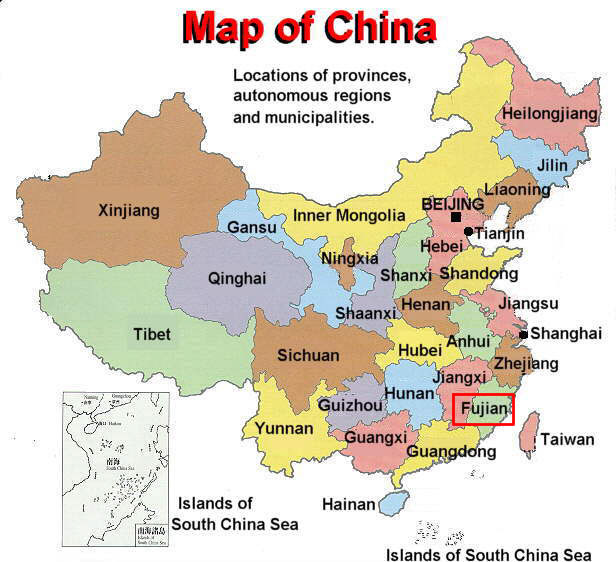
Large parts of the Wuyi Mountains have been under national protection since 1979 and have been part of the UNESCO network "Man and Biosphere" since 1987. Together with the tourist area they have been on the UNESCO list of natural and cultural heritage since 1999. According to UNESCO, the Wuyi Mountains are " one of the most outstanding subtropical forests in the world. It is the largest and most representative example of an almost intact forest that encompasses the diversity of Chinese subtropical forests and southern Chinese tropical rainforests. " During my expedition to the nature reserve 20 years ago, access for tourists was still closed. Today, everyone is allowed to explore the nature reserve on their own for a rather high entrance fee by Chinese standards.
However, most Chinese understand the Wuyi Mountains to be the Wuyi National Park, which is located in the southern foothills of the mountain range, only 15 kilometres from the city of Wuyi Shan. This area is also on the UNESCO list of natural and cultural heritage. The central attraction is the River of Nine Windings.
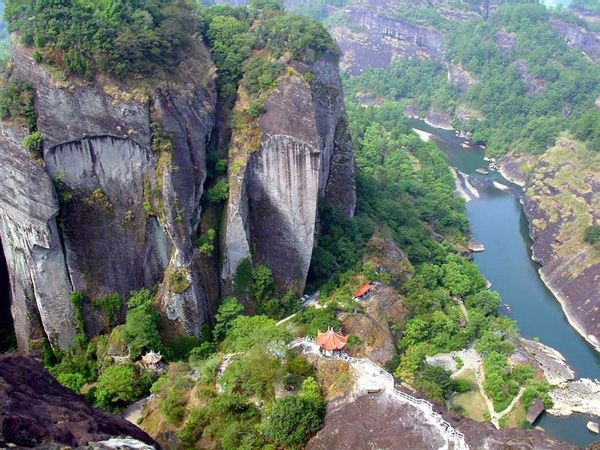
River of the nine bends The river has a total length of about 60 kilometres, only the lower course of the river is interesting for tourists. In a length of about 9 kilometres the river meanders through countless rocky cliffs and makes several, partly very sharp bends. There are several ways to explore the river, but the most original is with a bamboo raft: On the one hand, the bamboo raft is a typical means of transportation by water in southern China, on the other hand, you can never be sure what curiosity you will experience during a trip on the bamboo raft besides the beautiful landscape. My experience: One of the two raftsmen had fallen into the water during a nap (!!!) and took this as an opportunity to take a refreshing bath in the cool clean water. The other driver jumped, following the motto "what you can do, I can do much better", right after. Only when the two thought they had recovered enough from the midday heat did they get back on the raft and continue their journey.
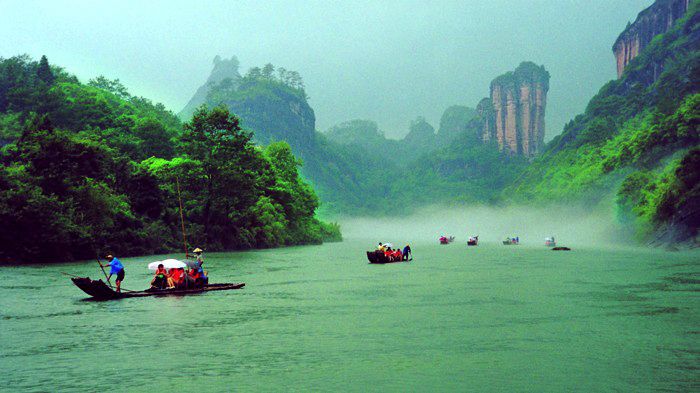 Bamboo raft on the river. The big rock in the background is the landmark of the Wuyi Mountains. It has the imaginative name "The Maid".
Bamboo raft on the river. The big rock in the background is the landmark of the Wuyi Mountains. It has the imaginative name "The Maid".
Of course you won't find anything like that in the UNESCO report.
What you won't find there either is that one of the best tea varieties in China is grown in the catchment area of this river:
The Wuyi rock tea,
an Oolong variety. The name "Rock Tea" is derived from the location of the tea plants:
Because the growing area is mainly rocky, farmers often had to make do with small bonsai-like tea gardens built on the rocks.
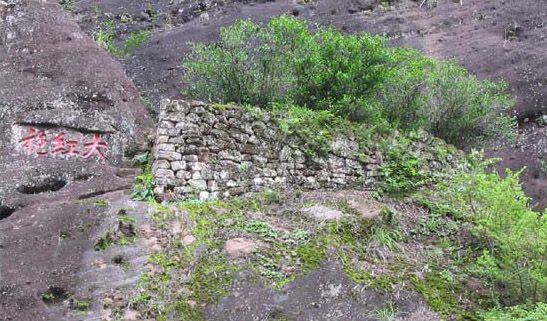 One of the few original specimens of the Dao Hong Pao (Big Red Robe). At the left side of the rock the name of the plant is engraved.
One of the few original specimens of the Dao Hong Pao (Big Red Robe). At the left side of the rock the name of the plant is engraved.
 One of the few original specimens of the Dao Hong Pao (Big Red Robe). At the left side of the rock the name of the plant is engraved.
One of the few original specimens of the Dao Hong Pao (Big Red Robe). At the left side of the rock the name of the plant is engraved.
The Yellow Mountain (Huang Shan) and surroundings
he Yellow Mountain is located in the province of
 Anhui
Anhui
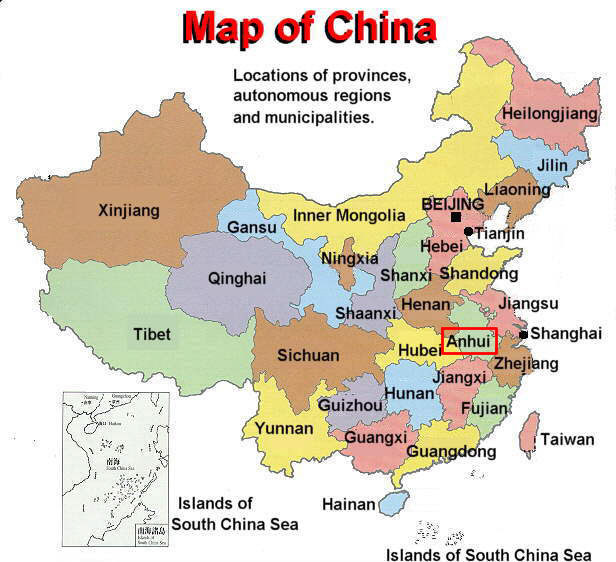 .
It is very easy to reach both from Shanghai (distance: approx. 400 kilometres) and from Hangzhou (distance: approx. 200 kilometres).
The Yellow Mountain is also one of the 10 most visited tourist destinations in China. It is also on the UNESCO list of cultural and natural heritage.
.
It is very easy to reach both from Shanghai (distance: approx. 400 kilometres) and from Hangzhou (distance: approx. 200 kilometres).
The Yellow Mountain is also one of the 10 most visited tourist destinations in China. It is also on the UNESCO list of cultural and natural heritage.
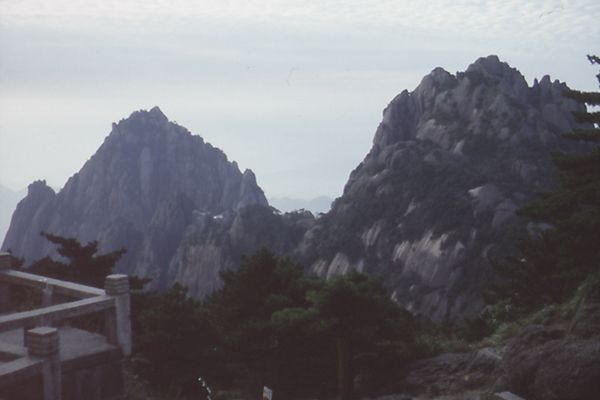 Huge mountains consisting only of rocks. Here in the picture the two highest peaks of the Yellow Mountain. On the right the Lotus peak, 1862 metres, on the left the Heavenly peak, 1840 metres.
Huge mountains consisting only of rocks. Here in the picture the two highest peaks of the Yellow Mountain. On the right the Lotus peak, 1862 metres, on the left the Heavenly peak, 1840 metres.
 Anhui
Anhui

 Huge mountains consisting only of rocks. Here in the picture the two highest peaks of the Yellow Mountain. On the right the Lotus peak, 1862 metres, on the left the Heavenly peak, 1840 metres.
Huge mountains consisting only of rocks. Here in the picture the two highest peaks of the Yellow Mountain. On the right the Lotus peak, 1862 metres, on the left the Heavenly peak, 1840 metres.
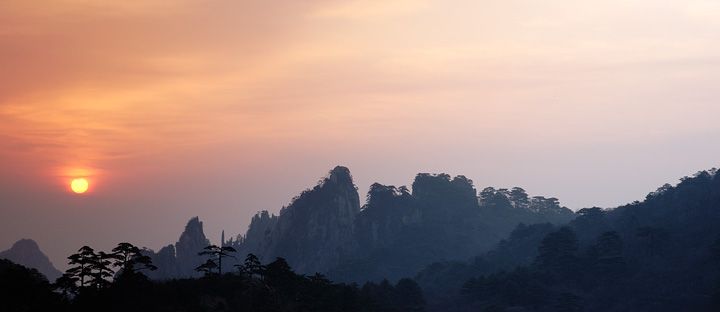
Sunset on the Yellow Mountain The Yellow Mountain was originally called Yi Mountain. Yi means "much black" in Chinese. So the Yellow Mountain was a black mountain. The reason: the rocks, for which the mountain is known, have a very dark, almost black colour. The mountain was later renamed in honour of the Yellow Emperor, the ancestor of all Chinese - according to legend, the Yellow Emperor cooked herbs on this mountain and found his immortality.
Rock formations, pine trees, seas of clouds and thermal baths are attractions that attract over 6 million visitors every year. Without doubt, the Yellow Mountain is considered the most beautiful mountain in China.
The mountain consists almost entirely of granite rocks, dotted with pine trees growing in the cracks in the rocks.
If you want to learn
 Chinese landscape painting
Chinese landscape painting
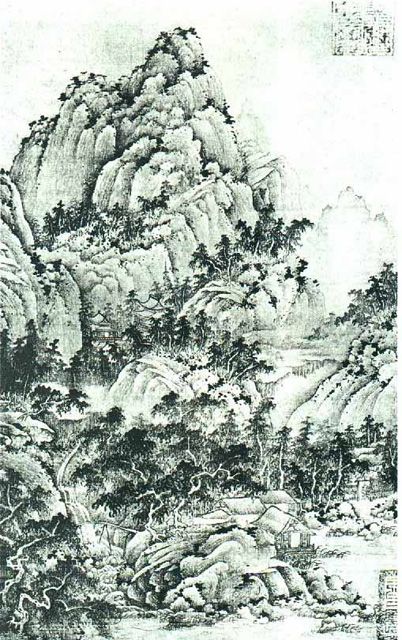 (a landscape painter from the 10th century. The resemblance to the rocks of the Yellow Mountain is unmistakable), a trip to the Yellow Mountain is a must.
(a landscape painter from the 10th century. The resemblance to the rocks of the Yellow Mountain is unmistakable), a trip to the Yellow Mountain is a must.
 The interaction between rocks and clouds
The interaction between rocks and clouds
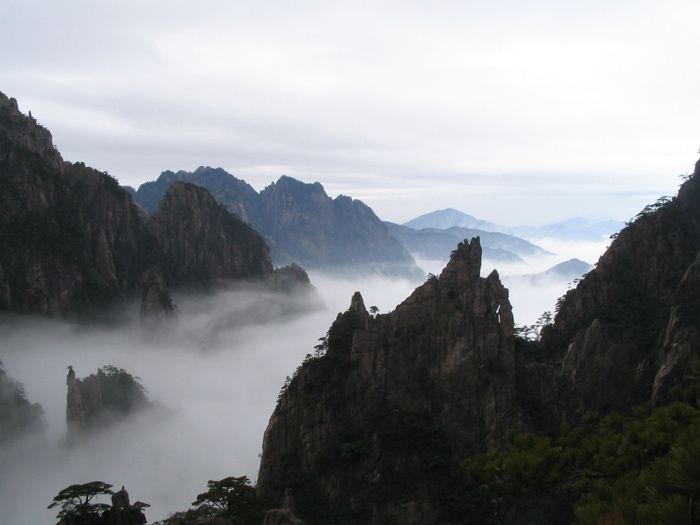 on the Yellow Mountain has inspired generations of painters.
on the Yellow Mountain has inspired generations of painters.
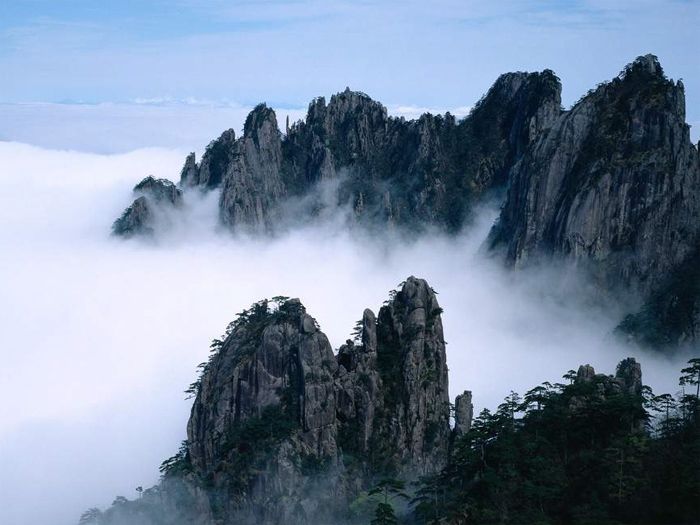 The rocky peaks rise from the sea of clouds like islands.
The rocky peaks rise from the sea of clouds like islands.
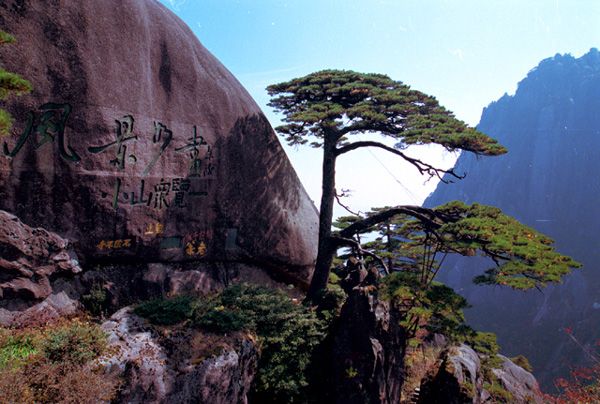 Probably the most famous pine tree in China. It is called the welcome pine tree because it looks like a person who is just reaching out to greet a guest.
Probably the most famous pine tree in China. It is called the welcome pine tree because it looks like a person who is just reaching out to greet a guest.
 Chinese landscape painting
Chinese landscape painting

 The interaction between rocks and clouds
The interaction between rocks and clouds

 The rocky peaks rise from the sea of clouds like islands.
The rocky peaks rise from the sea of clouds like islands.
 Probably the most famous pine tree in China. It is called the welcome pine tree because it looks like a person who is just reaching out to greet a guest.
Probably the most famous pine tree in China. It is called the welcome pine tree because it looks like a person who is just reaching out to greet a guest.
The surroundings of the Yellow Mountain
Some villages near the Yellow Mountain are particularly interesting from an ethnological point of view.
Two of them, Xidi (see picture)
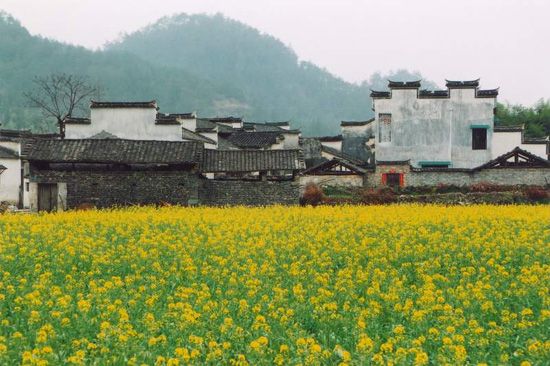
The village Xidi and Hongcun
Hongcun
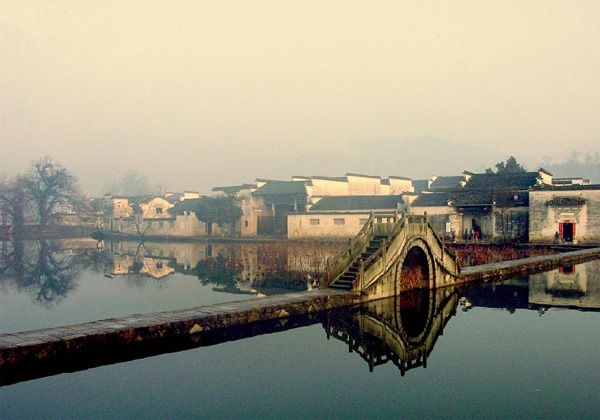 , are on the UNESCO World Heritage List. Some scenes of the kungfu poetry "Tiger and Dragon" were shot in the village of Hongcun.
, are on the UNESCO World Heritage List. Some scenes of the kungfu poetry "Tiger and Dragon" were shot in the village of Hongcun.
These villages and settlements in Southern Anhui, which are still inhabited today, have hardly been changed in the last centuries and are still very well preserved. Each individual settlement housed an entire family clan, i.e. the inhabitants all bear the same family name. Actually, the settlements are located in a region that was one of the poorest in China. But the wealth of the builders of that time can still be seen in the architecture and exterior decoration of the houses, in the interior decoration of the houses and in the planning of the settlements. How can this apparent contradiction be explained? Poverty makes legs. Many people fled their homes to seek their fortune in the big wide world.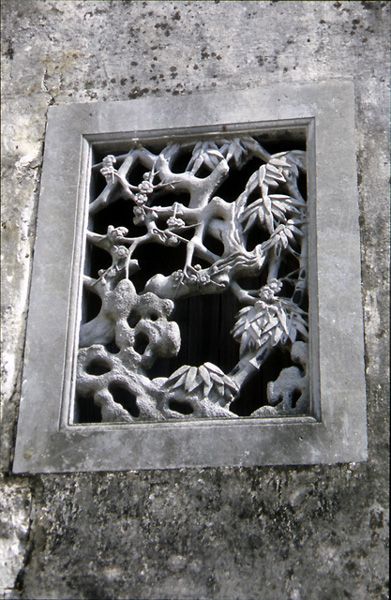
A window, decorated with stone carving Some actually became rich, mostly through trade, which is why in China they were called traders from "Hui" (the name of this region). According to Chinese tradition, they returned home and shared their wealth with their clans. They decorated their homes particularly well, built schools and ancestral temples for the whole clan and supported poorer families. It was not until the 19th century, when the close ties within the clan became increasingly loose, that this way of living together slowly disappeared from the picture of Chinese society.
The Huang Shan tea growing region is no less famous than the landscape and the cultural offerings. No less than two famous green teas come from the region: Huang Shan Mao Feng and Tai Ping Hou Kui. The Mao Feng is being built in the middle of the National Park of the Yellow mountain. The Tai Ping Hou Kui originally came from the Tai Ping from the city of Huang Shan. Today it is cultivated in several communities.
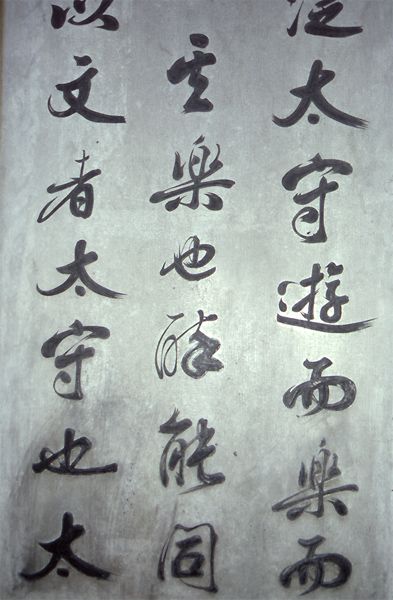 What looks like a normal calligraphy on paper here is in reality carved into a stone (approx. 2 meters x 3 meters). The text (here only an excerpt), a travelogue, was written by a famous writer of the Song Dynasty.
What looks like a normal calligraphy on paper here is in reality carved into a stone (approx. 2 meters x 3 meters). The text (here only an excerpt), a travelogue, was written by a famous writer of the Song Dynasty.

The village Xidi and
 Hongcun
Hongcun

These villages and settlements in Southern Anhui, which are still inhabited today, have hardly been changed in the last centuries and are still very well preserved. Each individual settlement housed an entire family clan, i.e. the inhabitants all bear the same family name. Actually, the settlements are located in a region that was one of the poorest in China. But the wealth of the builders of that time can still be seen in the architecture and exterior decoration of the houses, in the interior decoration of the houses and in the planning of the settlements. How can this apparent contradiction be explained? Poverty makes legs. Many people fled their homes to seek their fortune in the big wide world.

A window, decorated with stone carving Some actually became rich, mostly through trade, which is why in China they were called traders from "Hui" (the name of this region). According to Chinese tradition, they returned home and shared their wealth with their clans. They decorated their homes particularly well, built schools and ancestral temples for the whole clan and supported poorer families. It was not until the 19th century, when the close ties within the clan became increasingly loose, that this way of living together slowly disappeared from the picture of Chinese society.
The Huang Shan tea growing region is no less famous than the landscape and the cultural offerings. No less than two famous green teas come from the region: Huang Shan Mao Feng and Tai Ping Hou Kui. The Mao Feng is being built in the middle of the National Park of the Yellow mountain. The Tai Ping Hou Kui originally came from the Tai Ping from the city of Huang Shan. Today it is cultivated in several communities.
 What looks like a normal calligraphy on paper here is in reality carved into a stone (approx. 2 meters x 3 meters). The text (here only an excerpt), a travelogue, was written by a famous writer of the Song Dynasty.
What looks like a normal calligraphy on paper here is in reality carved into a stone (approx. 2 meters x 3 meters). The text (here only an excerpt), a travelogue, was written by a famous writer of the Song Dynasty.
The city of Suzhou
When people in China talk about beautiful cities, Hangzhou and Suzhou are usually mentioned in the same breath.
Suzhou (in
 Jiangsu
Jiangsu
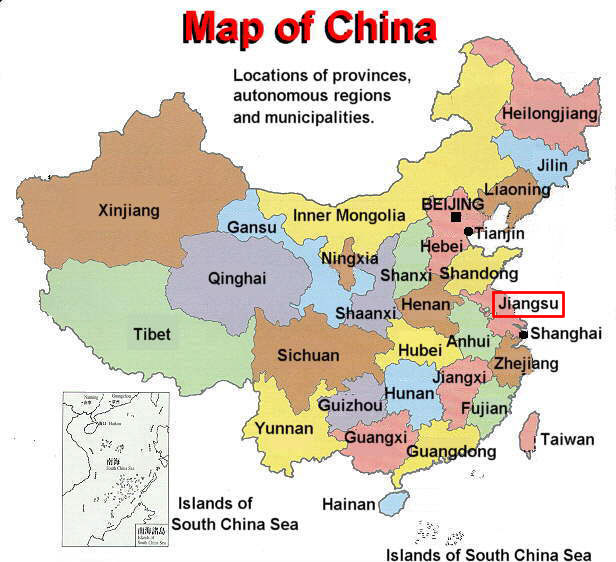 province) is also on the UNESCO World Heritage List. Only 80 kilometres west of Shanghai, Suzhou is one of the most popular destinations for Shanghai's urbanites.
province) is also on the UNESCO World Heritage List. Only 80 kilometres west of Shanghai, Suzhou is one of the most popular destinations for Shanghai's urbanites.
 Jiangsu
Jiangsu

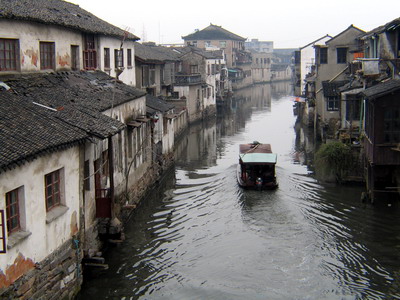
The city of Suzhou Suzhou is one of the oldest cities in China. It was built 2500 years ago as the new capital of the Kingdom of Wu, because the old one had become too small. Until the end of the 6th century, the city bore the same name as the kingdom, namely Wu. At the end of the 6th century it was renamed to its present name.
Since the city was built on the alluvial deposits of the great Yangtze River and Tai Lake (The Great Lake, the third largest freshwater lake in China, about the size of the Saarland), the cityscape was very much shaped by water: The city was criss-crossed by countless rivers and canals. In the long years after its construction, the cityscape hardly changed. The city still stands today on exactly the same square as it was built 2500 years ago. Residential buildings are built so close to the water that you could jump right into your living room from the boat, which served as both a means of transport and a means of transportation. No other city in China has more waterways and bridges. The Marco Polo report stated that Suzhou had 6000 bridges. More than 300 can be found today in any case.
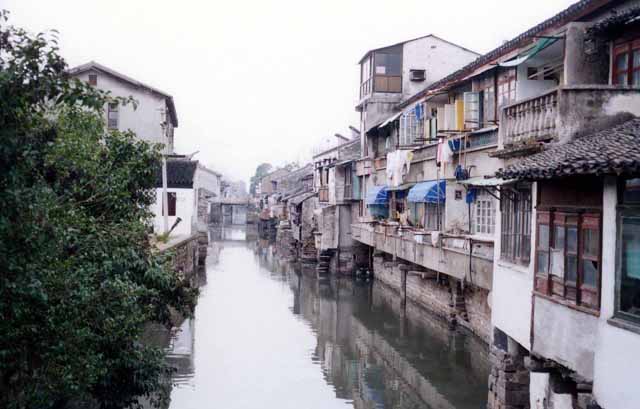 A waterway with the houses located directly on the water.
A waterway with the houses located directly on the water.
 A typical arch bridge (Gong Qiao) in Suzhou.
A typical arch bridge (Gong Qiao) in Suzhou.
The real attractions of Suzhou are its gardens. The about 20 - 30 very well preserved gardens in Suzhou represent the highest horticultural art of China.
uzhou's history of horticulture began as early as the 3rd century. In the 19th century horticulture reached its peak:
There were more than 300 gardens distributed throughout the city. Unfortunately, most of them were destroyed by the wars.
In the 60s, 190 gardens were still registered. After the Cultural Revolution, only about 30 of them have been preserved.
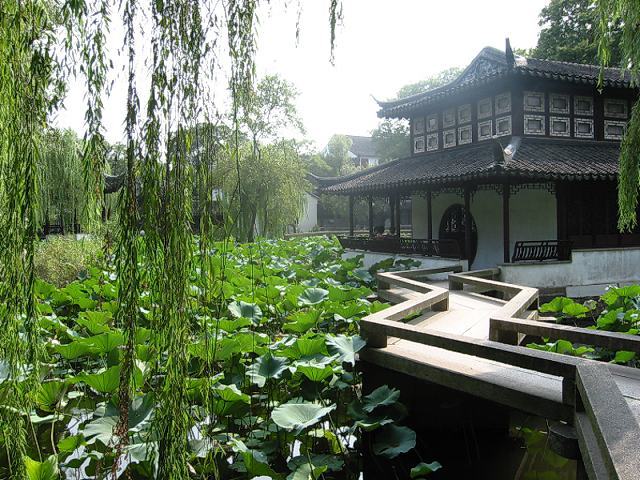 Zhuo Zhen Yuan (Garden of the foolish politician) with the zigzag bridge. The garden was built in 1509 by a failed politician. He chose the name for the garden after a poem from the 4th century, which said that gardening was the occupation of foolish people.
Zhuo Zhen Yuan (Garden of the foolish politician) with the zigzag bridge. The garden was built in 1509 by a failed politician. He chose the name for the garden after a poem from the 4th century, which said that gardening was the occupation of foolish people.
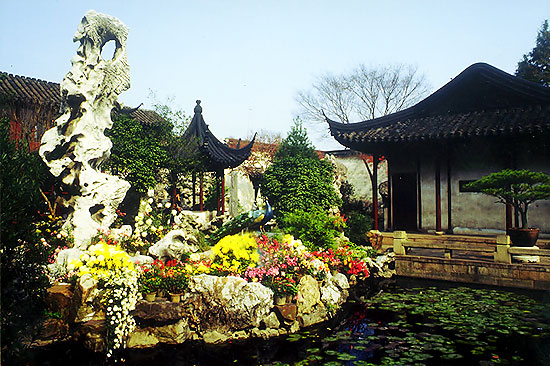 Liu Yuan (garden of lingering) with the bizarrely shaped stone, which is supposed to symbolize a mountain.
Liu Yuan (garden of lingering) with the bizarrely shaped stone, which is supposed to symbolize a mountain.
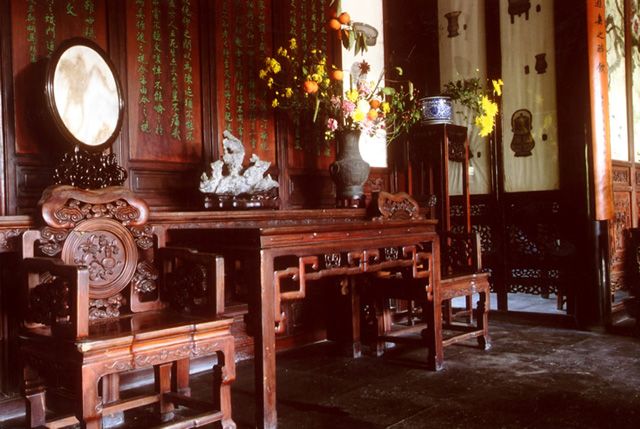
Furnishing of the reception hall of the Liu Yuan (garden of lingering) The builders of the gardens were mostly rich businessmen or retired civil servants. The gardens were part of their estate. Unlike traditional European gardens, which are dedicated either to flowers or trees, Chinese gardens are miniatures of the natural landscape: Lakes, rivers, mountains. Moreover, these garden elements are so cleverly laid out spatially that when you walk through the gardens you do not notice how small the gardens actually are. Especially pleasing for tea lovers is that many of these gardens have a tea house.
Suzhou has long been known as a tea-growing region. Already in the book by Lu Yu (see below) Suzhou was mentioned as one of the best tea growing regions. Today a green tea is grown here, which is almost as famous as the Lung Ching. The tea is called "Pi Lo Chun" (Jade Green Snail of Spring), which is said to have been named after the Qing Emperor Qianlong (reign: 1736 - 1796).
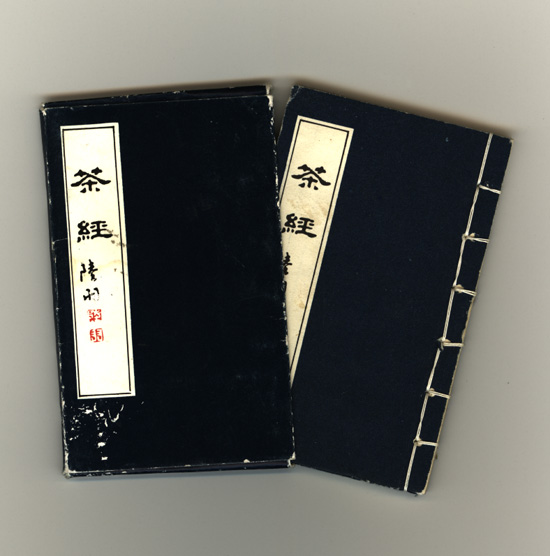 Shows a miniature edition of the "Classical book about tea". It measures only about 6 cm high and 4 cm wide. The book is bound in the traditional binding method with thread at the right margin. Reading is of course from right to left, from top to bottom.
Shows a miniature edition of the "Classical book about tea". It measures only about 6 cm high and 4 cm wide. The book is bound in the traditional binding method with thread at the right margin. Reading is of course from right to left, from top to bottom.

